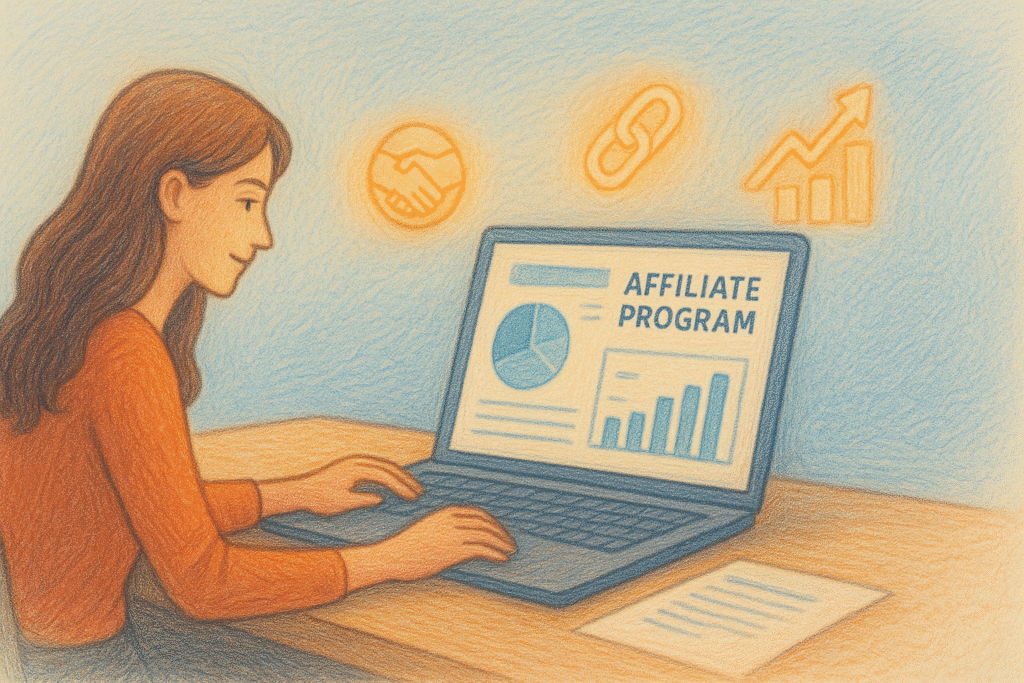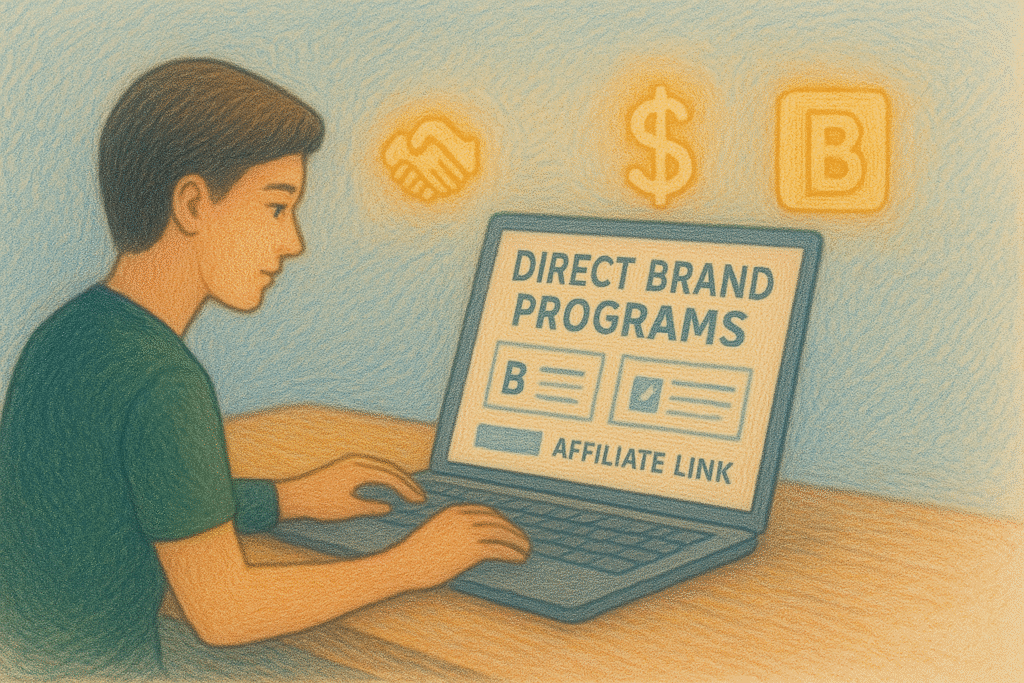Imagine this. You’re sitting in your hostel room, broke at the end of the month (again). The mess food is boring, your pocket money is gone, and Swiggy is tempting you with discounts you can’t afford.
Now imagine earning money online, not by starting a huge business, not by investing lakhs, but by simply recommending products and getting paid for it.
That, my friend, is affiliate marketing.
But here’s the catch: not all affiliate programs are worth your time. Some pay peanuts. Some are scams. And some are goldmines, if you know how to find them.
So, if you’re a digital marketing student (or just someone who wants to start earning online), let’s learn how to find the best affiliate programs that actually pay and build your career too.
First, Quick Recap: What is Affiliate Marketing?
Affiliate marketing = recommending a product online-someone buys via your link- you get commission.
You don’t handle shipping, payments, or customer service. Just marketing.
Simple formula:
You → Audience → Affiliate Link → Company → Commission
Now let’s figure out where to find these programs and how to choose wisely.
Why Choosing the Right Affiliate Program Matters
Think of affiliate programs like internships. Some give you exposure, some give you money, some waste your time.
Good programs = high commission, trusted brands, easy payouts.
Bad programs = shady products, low commissions, or complicated payment terms.
So, picking the right one can mean the difference between earning ₹500 or ₹50,000 from the same effort.

Step 1: Define Your Niche
Before joining random programs, ask yourself:
What do I enjoy talking about? (Tech, fashion, fitness, education?)
What do I already know?
What do my audience/friends care about?
Example: If you’re into gaming, an Amazon affiliate (for gadgets, consoles, accessories) makes sense. If you’re into career growth, promoting courses on Coursera or Udemy works better.
Step 2: Explore Affiliate Marketplaces
Instead of searching brand by brand, check out affiliate marketplaces where hundreds of programs are listed.
Some good ones:
ClickBank- Famous for digital products (e-books, software).
CJ Affiliate (Commission Junction)- Trusted brands, global.
ShareASale- Huge variety of products.
Impact- Great for premium brands.
Marketplace = one-stop shop. You can test different programs without signing up everywhere.
Step 3: Check Direct Brand Programs
Big companies often run their own affiliate programs. These are usually more reliable.
Examples:
Amazon Associates- Easiest for beginners, massive range.
Flipkart Affiliate- Good for Indian students.
Hostinger / Bluehost- Web hosting (high commission, ₹5,000-₹6,000 per signup).
Coursera / Udemy- Courses, perfect for students.
Nike / Myntra / Ajio- Fashion (great if your audience is Gen Z).
Direct programs are trustworthy and usually have better support.

Step 4: Compare Commission Rates
Here’s the truth: commissions vary A LOT.
Amazon: 1%-10% (depends on category).
Web hosting (like Hostinger): ₹5,000+ per sale.
Online courses: 20%-40% commission.
Software (like Canva, SEMrush): recurring monthly commission.
Pro Tip: High commission is great, but always balance it with product demand. A ₹500 software nobody buys is worse than a ₹100 shampoo that sells daily.
Step 5: Look for Student-Friendly Programs
As a student, you need:
Easy sign-up (no company registration required).
Low payout threshold (so you’re not stuck until you earn ₹10,000).
Popular products (things students actually buy).
Best beginner-friendly picks:
Amazon Associates
Flipkart Affiliate
Coursera Affiliate
Canva Affiliate
Hostinger Affiliate
Step 6: Check Payment Methods
Imagine earning commissions but not being able to withdraw them. Heartbreak!
Always check:
Does the program pay to Indian bank accounts or PayPal?
Minimum payout limit (₹1,000 is fine, ₹10,000+ is tough for beginners).
Payment cycle (monthly, 45 days, 60 days).
Example: Amazon India pays via NEFT once you cross ₹1,000. Easy for students.
Step 7: Read Reviews & Terms
Some programs look good but hide traps:
Delayed payments
Limited product range
Strict rules (you can’t promote on social media, etc.)
Always Google: “XYZ affiliate program review” before signing up. Learn from others’ experiences.

Mini Case Study: Arjun’s Affiliate Journey
Arjun, a B.Com student, started a YouTube channel reviewing budget smartphones.
-
He joined Amazon Associates.
-
Added affiliate links in video descriptions.
-
Within 3 months, he sold 200+ gadgets via his links.
-
Earned ₹15,000 in commissions (without spending on ads).
Lesson: Even beginner-friendly programs like Amazon can make real money if you’re consistent.
Quick Do’s & Don’ts
✅ Do choose a niche you care about
✅ Do join trusted programs (Amazon, Coursera, Canva)
✅ Do check payment terms before starting
✅ Do create honest, helpful content
✅ Do experiment with 2–3 programs before scaling
❌ Don’t sign up for shady, unknown programs
❌ Don’t spam links on WhatsApp groups
❌ Don’t pick products you wouldn’t use yourself
❌ Don’t expect ₹1 lakh in month one
❌ Don’t ignore reviews & terms
Checklist: How Students Can Find the Best Affiliate Programs
Pick your niche
Search affiliate marketplaces (ClickBank, ShareASale)
Check direct brand programs (Amazon, Flipkart, Canva)
Compare commissions
Ensure student-friendly payouts
Check payment methods (PayPal, bank transfer)
Read reviews and terms
Start with 1-2 programs, then expand
Final Thoughts
Affiliate marketing isn’t about luck. It’s about choosing the right program and putting in consistent effort.
As a digital marketing student, learning how to pick affiliate programs is a skill in itself. It teaches you to research, analyze, and think like a marketer.
Start small. Maybe join Amazon Associates today. Add a few links in your Instagram bio or blog. See how it works. Once you get the hang of it, scale up to high-paying programs.
Because tomorrow, the same affiliate skills could make you ₹5,000, ₹50,000, or even build your own digital empire.
Remember: Don’t just chase commissions, chase credibility. The money will follow.

